Our Products
-
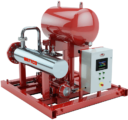
Immersion Heaters
In an industrial setting, immersion heaters are installed in containers, tanks, and processing equipment where they are utilized for heating liquid solutions. Using the direct heat transfer process, immersion heaters are able to heat liquids to the desired temperature quickly. Electric immersion heaters are cost-efficient and use cleaner energy. Types of immersion heaters include over the side heaters, circulation heaters, screw plug heaters, and flange heaters.These electric heating elements require minimal maintenance and feature standard 1-inch conduit openings as well as 0.315”, 0.375”, 0.430”, or 0.475” diameter elements. Sheath materials include stainless steel, steel, and Incoloy®. Immersion heaters can be custom designed for the specifications of your application.
-
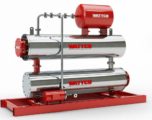
Circulation Heaters
Circulation heaters are composed of an electric heater heater housed in a steel, carbon steel, stainless steel, Incoloy®, Inconel®, or titanium vessel. A pump is used to flow oils, water, or process liquids through the closed pipe circuit where heat is applied. When choosing a circulation heater for an application, viscosity must be considered to ensure the liquid will be capable of circulating within the pipes; therefore, a range of watt densities are available to achieve the appropriate viscosity. These electric heating elements feature drain valves, allowing for simplified maintenance. Vertical or horizontal mounting options are available for this water heater element.
-
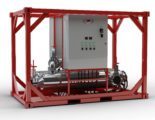
Inline Heaters
Inline heaters are also known as circulation heaters. They are suitable for applications which require intermediate heating where the process fluid must maintain a flow rate. Inline heaters are composed of a flanged heater ranging from 2 inches up to 14 inches, housed in an anti-corrosive vessel chamber made of steel, stainless steel, copper, titanium, Incoloy®, or Inconel®. This electric heating element directs heat that is transferred from an electrical power source into the liquid. Inline heaters offer regulation and control of temperature using digital control panels and thermocouples. Inline heaters can also be used to maintain the viscosity of the fluid. They are easy to install and compatible with industrial heating piping currently in use.
-
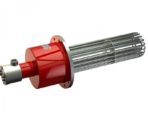
Flanged Heaters
Flanged heaters are mounted on the sides of tanks to provide direct heating for liquids. They are a popular heating option for oil sector applications. Flanged heaters are made of a variety of different alloys, including steel, stainless steel, copper, titanium, Incoloy®, and Inconel®, with a heavy wall sheath of 0.028” up to 0.065” thickness available in steel, stainless steel, Incoloy®, and Inconel®. Choosing the appropriate alloy for the water heating element will prevent corrosion and extend the service life of the flanged heater. Flanged heaters are custom built to the wattage appropriate for your application, up to 660 volts.
-
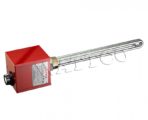
Screw Plug Heaters
Screw plug heaters are a form of electric heater used to heat gases and liquid solutions in smaller tanks where fine temperature control is also required. A screw plug heater screws into the tank wall or vessel, or can also be installed within piping. The screw plug heater is immersed in the solution to offer rapid heating. Mechanical thermostats or industrial control panels allow screw plug heaters to achieve target temperatures accurately. Sheath materials include copper, steel, stainless steel, titanium, Incoloy®, and Inconel®. Energy-efficient NPT screw plugs are available in 1”, 1 ¼”, 1 ½”, 2”, 2 ½”, 3”, and 4’’.
-
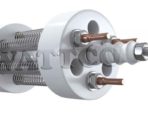
Pipe Heater
Pipe heaters provide indirect heating to the liquid. Use pipe heaters in tank applications as water heating elements or for other substances requiring low watt densities, such as molasses, waxes, tar, and corrosive substances. During the heating process, the pipe heater never comes in contact with the liquid. Pipe heathers are specifically designed to fit within 2” to 3” horizontal schedule 40 NPS piping. Maintenance and replacement of the pipe heater is simplified, as there is no need to drain the tank in these scenarios. Pipe heaters may use coiled, tubular, flanged, or screw plug heaters depending on the needs of the application. Pipe heaters offer easy installation, even heat distribution, and extended service life.
-
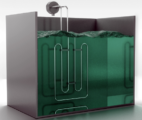
Over the Side Heaters
Over the side heaters are designed to be installed in the upper part of a tank. Using this approach, there is adequate space available in the tank for operations. Using over the side heaters creates uniform temperatures while maximizing process heating efficiency. The over the side heater can be conveniently removed upon heating the liquids to the desired temperature. The portability of over the side heaters offers the flexibility to be used in various applications. Over the side heaters utilize heating elements made of steel, copper, titanium, or cast alloy, coated in fluoropolymer or quartz for added protection; diameter sizes include 0.315”, 0.375”, 0.430”, and 0.475”.
-

Industrial Boiler Heaters
Steam and hot water boilers are used in facilities for a variety of purposes. Electric boilers are the most efficient option available for heating steam and water, making them a popular choice for commercial and industrial operations. With pressurized fluids contained inside, boiler heaters are designed for efficient heating as well as building safety. Boiler heaters are easy to install and the flange heaters they use can be replaced easily, lowering maintenance expenses. Various sizes offering a range of wattages are available to meet the specific needs of your application. Square and round flanges are available.
-
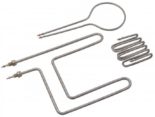
Tubular Heaters
Tubular heating elements composed of steel, stainless steel, Incoloy®, Inconel®, and titanium alloys are the foundation of virtually all industrial heating elements. With a strong exterior sheath, the heater is protected from stress while facilitating efficient heat transfer. Tubular circulation heaters offer great flexibility and are suited for use in a wide variety of applications to heat gases, solids, and liquids, processing temperatures of up to 750 °C. Standard diameter sizes include 0.260”, 0.315”, 0.375”, 0.430”, 0.475”, and 0.625”, allowing you to adjust watt densities to achieve optimal performance and extend equipment life. Tubular heaters feature silicone seals to control humidity, offering superior moisture resistance.
-
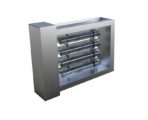
Finned Tubular Heating
Finned tubular heaters are suited for forced convection heating of air or gas. Fins are attached to the electrically insulated heater sheath, offering fast heat dispersion and superior heat conductivity. Custom bends are available, and finned tubular heaters can be configured to most any shape in order to meet the needs of your application. Finned tubular heaters offer watt densities up to 120 WPSI. They are easy to install and replace, reducing down time. Standard diameters for finned tubular heaters include 0.260”, 0.315”, 0.375”, 0.430”, 0.475”, and 0.625”. Sheath materials available include copper, steel, stainless steel, titanium, Incoloy®, and Inconel®.
-
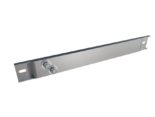
Strip Heaters
Strip heaters utilize their surface area to conduct direct heat transfer. These heaters can reach temperatures of up to 500°F, and provide adequate and inexpensive heating for smaller areas and surfaces indoors. Components of a strip heater include the heating element, a protective sheath made of steel, stainless steel, iron, aluminum, or zinc-coated steel, and mounting hardware. Strip heaters are insulated with magnesium oxide, mica, or fiberglass to minimize heat loss. Temperatures can be easily controlled by installing a mechanical thermostat or bimetal thermostat on the surface of the heater. Strip heaters can also be used in applications requiring radiant heat.
-
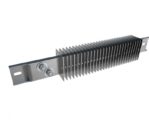
Finned Strip Heaters
Finned strip heaters allow you to transfer heat in a targeted area effectively by increasing heating intensity as well as surface are. Finned strip heaters utilize mechanical or bimetal thermostats installed on the heater surface for temperature control. Finned strip heaters are versatile and commonly used in applications such as process air heating, space heating, and food warming. They can be used as duct heaters or radiant heaters; their fins expand surface area, allowing for optimal heat transfer. Finned strip heaters are easy to install by clamping or bolting to the surface being heated. Finned strip heaters can heat to temperatures up to 500°F.
-
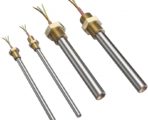
Cartridge Heaters
Cartridge heaters are fit tightly within a cartridge, and can house a thermocouple inside for accurate temperature control. The sheath of a cartridge heater can reach temperatures of up to 1400°F and are suited for high temperature applications, such as molds, sealing, and metal dies. Sheath materials include stainless steel, Incoloy®, and titanium. Cartridge heaters are made of high-grade nickel chromium resistance wire that is wrapped around a magnesium oxide core housed in a stainless steel casing. Cartridge heaters are designed for safety using high-quality materials. They are designed to maximize heat transfer as well as maintain even temperatures.
-
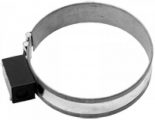
Band Heaters
Band heaters provide indirect heating for tanks. Fitting around the exterior of a drum or pipe, they heat the surface of the container to create progressive, uniform heat transfer. This method of heating is safe for use to heat volatile substances which are too dangerous to heat via direct methods. Band heaters are energy efficient and offer flexibility for use in various applications. Band heaters feature a built-in insulating mat composed of ceramic fiber. The outer stainless steel shell can reach temperatures of approximately 350°F to 450°F. Medium to high range band heaters can reach internal temperatures of up to 1200°F.
-
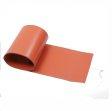
Silicone Rubber Heaters
Silicone rubber heaters are used in low to medium temperature applications of up to 450°F that are irregular dimensions and shapes. Silicone rubber heaters are used to provide direct heat where traditional heaters are unable to be installed. Made of fiberglass reinforced silicone rubber, these heaters are highly flexible and durable. Silicone rubber heaters can be affixed to surfaces using pressure sensitive adhesives or field-applied adhesives, or they can be mounted mechanically using various methods. The standard thickness of silicone rubber heaters is 0.056”, with lengths ranging from 1” to 120” and widths ranging from 1” to 36”.
-
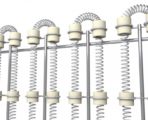
Open Coil Elements
Open coil heaters offer a highly efficient option as an electric heating element which is economical for use in most applications. Using open circuits, air is directly heated by suspended resistive coils ranging in diameter from 0.250” to 0.875” with wire gauges of 6 gauge up to 38 gauge. Open coil heaters are designed to fit within 2” or 3” schedule 40 NPS pipe. Open coil heaters provide fast heating times, lowering energy consumption and improving efficiency. Use open coil heaters for applications requiring even heating distribution across broad surface areas, including duct heating, pipe heating, forced air heating, and ovens. They are easy to maintain and replacement parts are inexpensive.
-
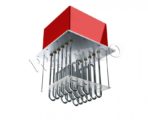
Duct Heaters
Duct heaters are used in ventilation and comfort heating applications, as well as industrial heating situations involving non-pressurized air heating. Types of duct heaters include tubular, finned tubular, and open coil. The electric heating elements are inserted directly into the duct or flanged. Duct heaters can be custom designed and built to fit the specific needs of your industrial heating product, with capacities of as much as 1000kW. Duct heaters are easy to install and maintain or service. Repairs or replacement can be performed quickly to minimize downtime. Duct heaters are versatile and offer optimal heat transfer with minimal heat loss.
-
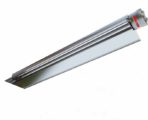
Electric Infrared Radiant Heaters
Electric Infrared heaters produce clean, radiant heating for heating in exposed indoor or outdoor areas. Infrared heaters can be used in process applications, to provide comfort process heating, and can be used in food service to maintain target temperatures. Infrared heaters utilize tubular circulation heating elements to produce direct heat transfer. The terminals are protected from moisture penetration and excessive humidity by waterproof housing. They are resistant to harmful corrosion and oxidation. Mechanical or digital controls are used to adjust and regulate temperatures. Infrared heater tubing options include: singular tubing elements, double tubing elements, hairpin tubing elements, quartz tubing, double quartz tubing, and quartz lamp elements.
-
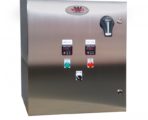
Wattco™ Temperature Control Panels
Digital control panels regulate temperatures, protect the heater element, and prevent overheating and other issues such as chemical disintegration. The control panel can be customized for your application to ensure safety while maintaining accurate and efficient heat transfer. Digital control panels offer ambient and target temperature readings for the solution being heated. There are multiple terminal box options available, including NEMA 1, NEMA 4, NEMA 7 explosion proof, dust-proof, and waterproof. The terminal box houses the various components of a digital control panel, including contactors, fuses, relays, and on-off switches. Digital control panels arrive ready to connect for quick installation, and are compatible with various materials including dangerous and corrosive materials.
-
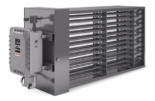
Explosion Proof Duct Heaters
For use in hazardous areas, these duct heaters come with explosion-resistant cast aluminum terminal enclosure and redundant over temperature protection. Sized to fit the duct. Heavy wall, large diameter finned tubular elements, individually removable for servicing. Tubular and finned designs can provide outlet air temperatures up to 650C (1200F) for industrial heating applications. Applications include petrochemical plants, aircraft hangars, fuelling areas, oil drilling rigs, sewage treatment plants, pipeline pumping stations, paint spray booths, storage areas for flammable products, labs or testing areas.
-
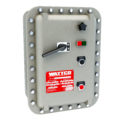
Explosion Proof Temperature Control Panels
Explosion Proof Temperature Control Panels (sometimes abbreviated as ‘HAZLOC’) can be ordered in all formats including: On-Off, Multistage, SCR direct and hybrid control panel options. They are designed not create a spark for potentially dangerous locations that have high concentrations of volatile liquids or gases that can ignite and cause explosions.
-
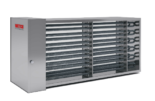
Finned Tubular Duct Heaters
Finned Tubular Duct Heaters are some of the most in demand duct heaters in the market. One of the leading uses of tubular duct heaters is to process air in industrial heating applications and to temper forced air in a number of industrial processes. The heater can come in a number of different wattages. This will largely dependent on the outlet of air temperature and the velocity of the air coming through inside the duct heaters.
-

Industrial Uses For Hybrid Temperature Control Panels
The Solid State Switching devices are semi conductor devices that control the power, either voltage or current that is supplied to the production system. While their job is primarily to switch the power on and off at rapid pace according to the instructions of the controller, they are capable of doing multiple standalone functions that primary include diagnostic functions and supervisory functions.
-
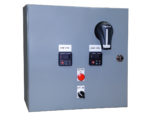
Industrial Uses For Multistage Temperature Control Panels
A more advanced control panel. The multistage control panel can handle heating or timing tasks with more than one stage required. This is very common in several industrial process, where temperatures have to hit certain benchmarks at different points in the process.
-
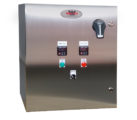
On Off Control Panels (Nema 4)
On/Off Control panels with Nema 4 designation are made for indoor and outdoor use and can withstand a large number of environmental factors while still protecting internal controls. Nema 4 desgination requires the enclosure to protect against: wind blown dust and particles, falling or hose directed water as well as protection from ice and freezing.
-
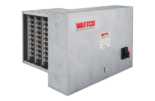
Open Coil Duct Heaters
Open Coil Duct Heaters are ideally used to heat commercial spaces such as offices, or retail spaces. Since they use open coils, they are extremely efficient at heating passing air as heat is transferred directly from the coil to the air. Wattco open coil heaters can be used to heat vertical or horizontal passing air.
-

SCR Direct Control Panel
Also known as Phase Angle Controllers or solid state switching device – work using the modulation of the load voltage until the targeted temperature is reached. Its smoother temperature control (virtually no noise) makes it a preferred choice over mechanical contractors which involves full load on/off during a cycle and improves your temperature response time.
-
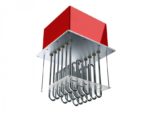
Tubular Duct Heaters
Tubular Duct Heaters are some of the most commonly used duct heaters available. Unlike finned tubular duct heaters, these heaters do not hav fins, so their heat dissipation rate is lower than their finned variants. Tubular duct heaters are often used in large scale space heating where open coils are not available.
